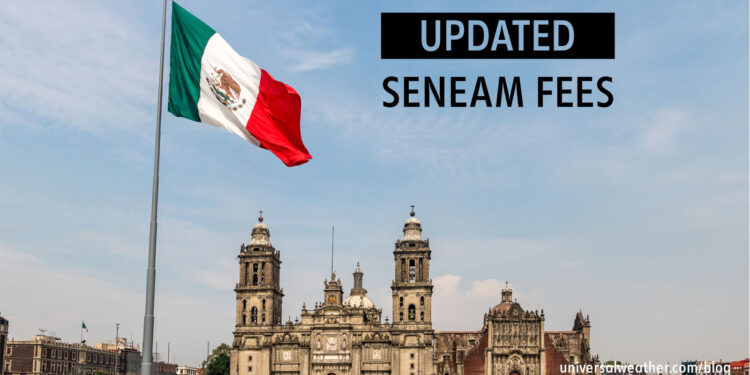SENEAM Fees for Travel to or over Mexico – Part 1: Calculating Fees & Managing Payments

This business aviation blog post is part of a series on SENEAM fees and how to manage them.
Servicios a la Navegacion en el Espacio Aereo Mexicano (SENEAM) fees are incurred when operating within Mexican airspace and when using airports outside of normal operating hours (overtime). These fees cover navigation services such as NAV aids, radio services, radar surveillance, etc. For airspace use SENEAM fees are based on wingspan and great circle distance through Mexican airspace. Paying all SENEAM fees due is an important consideration because, if they aren’t settled, you leave yourself open to being blocked from using Mexican airspace and/or detained on the ground.
For business aircraft operations into Mexico, the following is an overview of what you need to know:
1. SENEAM basics
Regulations for SENEAM fees have been outlined for years. However, active enforcement of the fee collection was only initiated in March 2012. There are two ways of paying SENEAM fees: either at time of fuel uplift when operating into Mexico or directly to SENEAM in the form of a bank transfer when the aircraft overflies the country. There’s been some confusion among operators on exactly how to settle these fees and how to bring outstanding SENEAM fees up-to-date. It’s important to note that SENEAM fees are self-calculated by operators and paid directly in the form of bank transfers.
2. Airspace use fees
These are self-determined/self-monitored fees that operators must pay. SENEAM airspace fees are based on wingspan and kilometers flown through Mexican airspace. You can go online to view official distances that must be used for fee calculations. Operators must determine payments due to SENEAM and pay this directly via a peso-denominated transfer via a Mexican bank. Alternatively (and this is recommended) your 3rd-party provider may calculate and make SENEAM fee payments on your behalf. Operators may also settle SENEAM fees, for operations into/out of Mexico, at the time of fuel uplifts in Mexico.
3. Airport overtime fees
Operators must also pay a SENEAM fee for any overtime at airports in Mexico that do not operate 24 hours. For example, Los Cabos (MMSD) closes at 1800 local. So, if you’re approved for overtime at MMSD, SENEAM fees are applicable. Note that these fees are separate from and in addition to any overtime fees that the airport charges. Basically, there are two layers of overtime fees due when using Mexican airports after hours. If you simply pay the airport overtime fees but not SENEAM overtime fees, you’ll have issues on future flights into or over Mexico.
4. Authority for SENEAM fees
The Secretaria de Communications y Transportes (SCT) is the authority that monitors SENEAM and collection of applicable fees. Over the years SENEAM fees tend to increase. The most recent change/increase took place in April 2014.
5. Calculating fees
SCT publishes an online chart listing relevant wingspan categories as well as pre-determined kilometer distances based on all routes into, out of, and within Mexico. If your particular routing, for example Billings (KBIL) to Toluca (MMTO), is not found on the chart, you’ll need to contact SENEAM for the official kilometer distance to use in your calculation. In the case of SENEAM airport overtime charges, these are based on actual overtime, as calculated per minute, and are not influenced by either wingspan or maximum takeoff weight.
6. Making payments to SENEAM
The deadline to settle SENEAM airspace or airport overtime fees is the 10th day of the month following the month fees were incurred. If payments aren’t made by the 10th of the following month, you’re in violation. And, if payment has not been received by SENEAM by the 17th of the following month, you’ll be suspended from the right to operate to or over Mexico. Note that, if you overpay SENEAM fees, you’ll not be able to use any remaining credit for other SENEAM fees due. And, trying to get a refund on overpaid fees can take several months. Operators who find themselves suspended can still pay the outstanding SENEAM fees, and this process usually requires about four hours on a normal business day. If you try to settle fees owed on a weekend or just prior to a weekend, the process takes longer. If you are on the ground trying to settle these fees on the weekend or close to it, you may find yourself held on the ground in Mexico for some time.
7. Paying fees with fuel uplifts
If you pay SENEAM fees at the time of fuel uplift, the calculations for the fees will already have been done, and you’ll not need to forward a bank transfer to SENEAM. If you’re making multiple stops within Mexico, applicable SENEAM fees will be collected with each fuel uplift. When paying SENEAM fees at the time of fuel uplift, be mindful that you’re only paying navigation fees for that particular operation. Outstanding fees, for any other flights, must still be paid to SENEAM via bank transfers.
Conclusion
As SENEAM does not invoice for fees due, it’s best to use a 3rd-party provider to calculate and pay any fees due as well as to contact SENEAM to determine if any SENEAM fees are outstanding. This includes if you recently acquired a pre-owned aircraft (which we’ll cover in part 2 of this article series). If you’re paying SENEAM fees directly, be sure to calculate the correct amount in pesos and pay this as via a transfer via a Mexican bank.
Stay tuned for Part 2, which covers information on dealing with suspensions for travel to Mexico due to SENEAM outstanding fees.
Questions?
If have any questions about this article or would like assistance with this or other aviation regulatory issues, contact me at juanmuniz@univ-wea.com.




